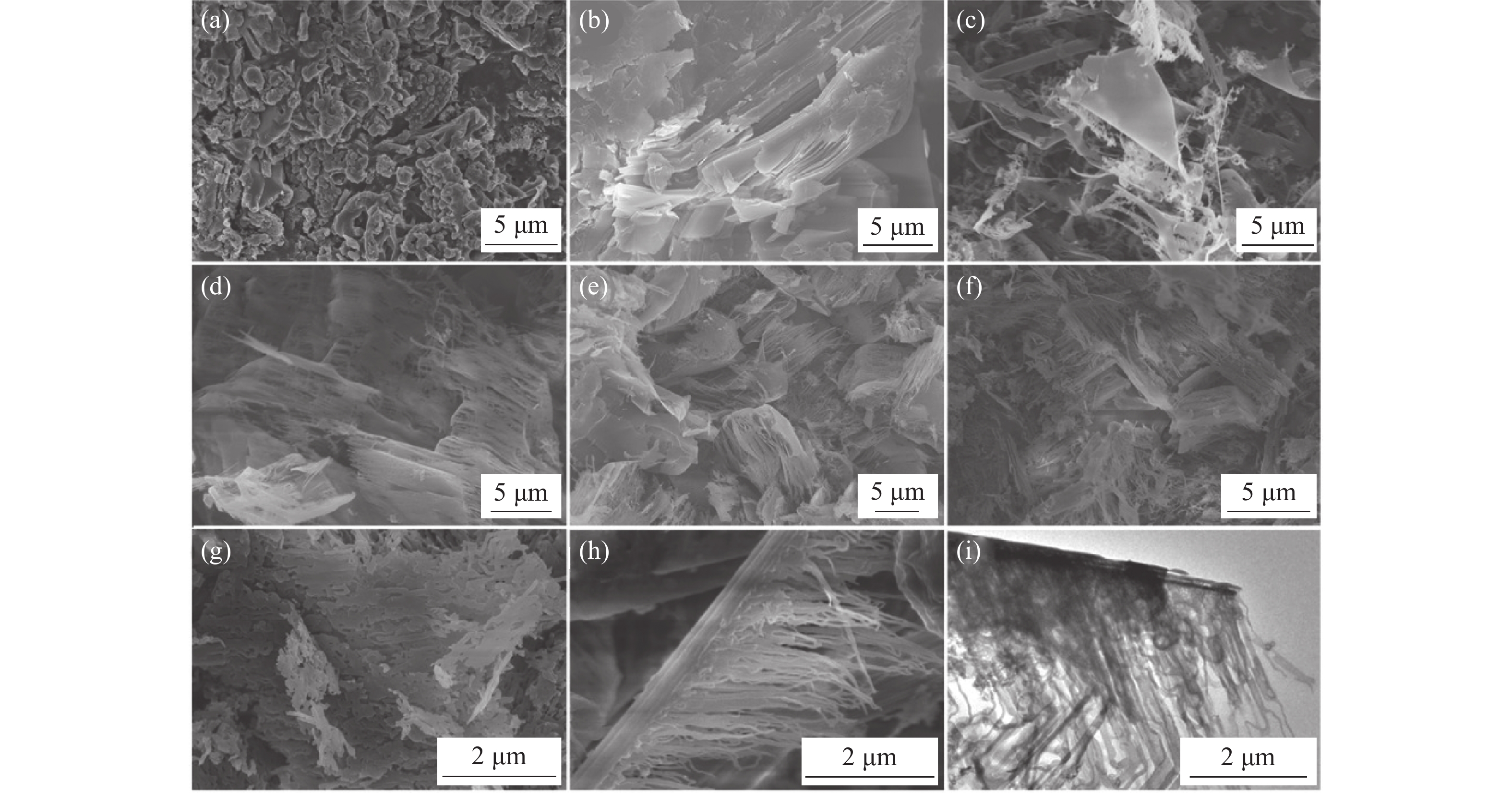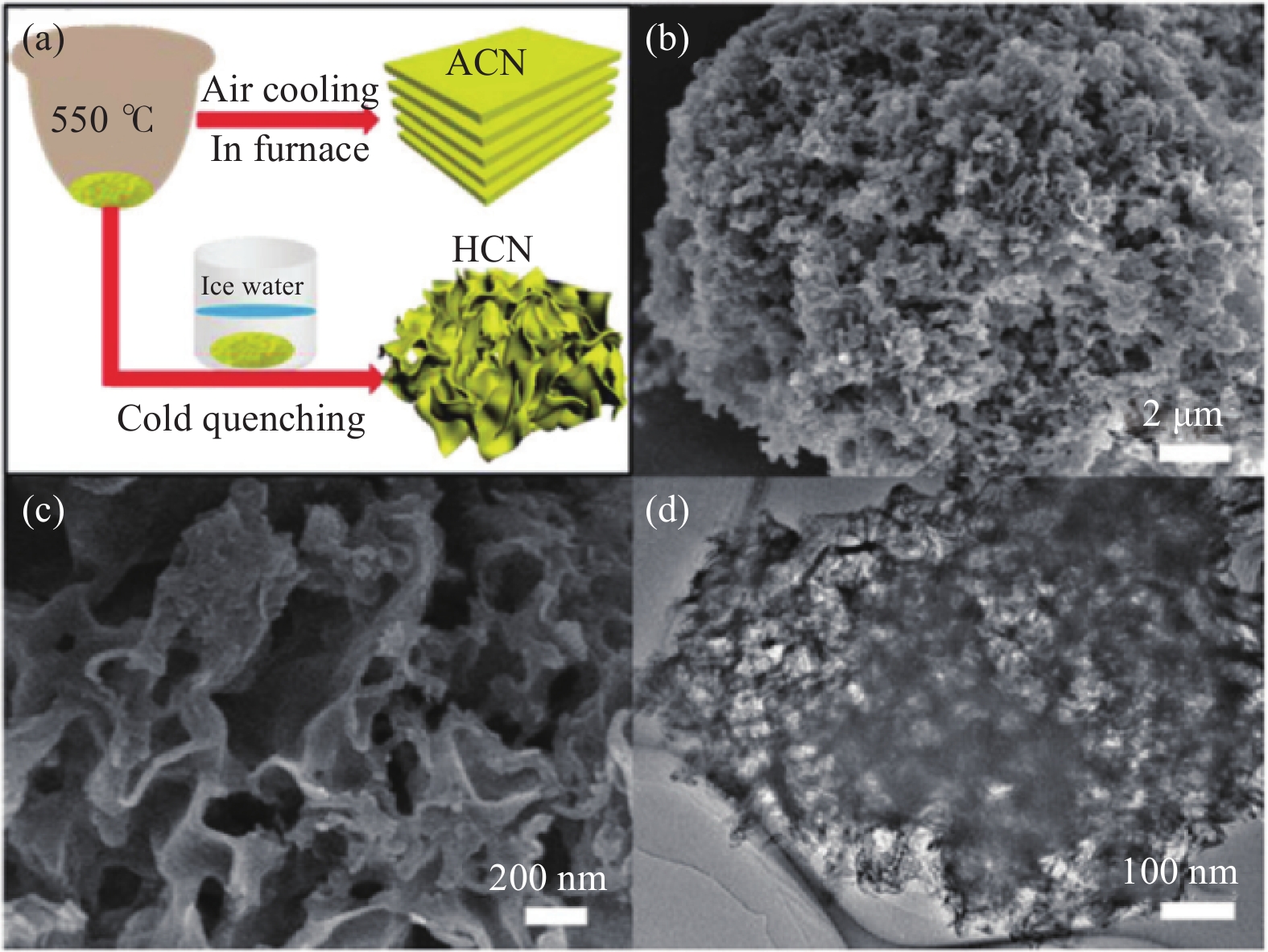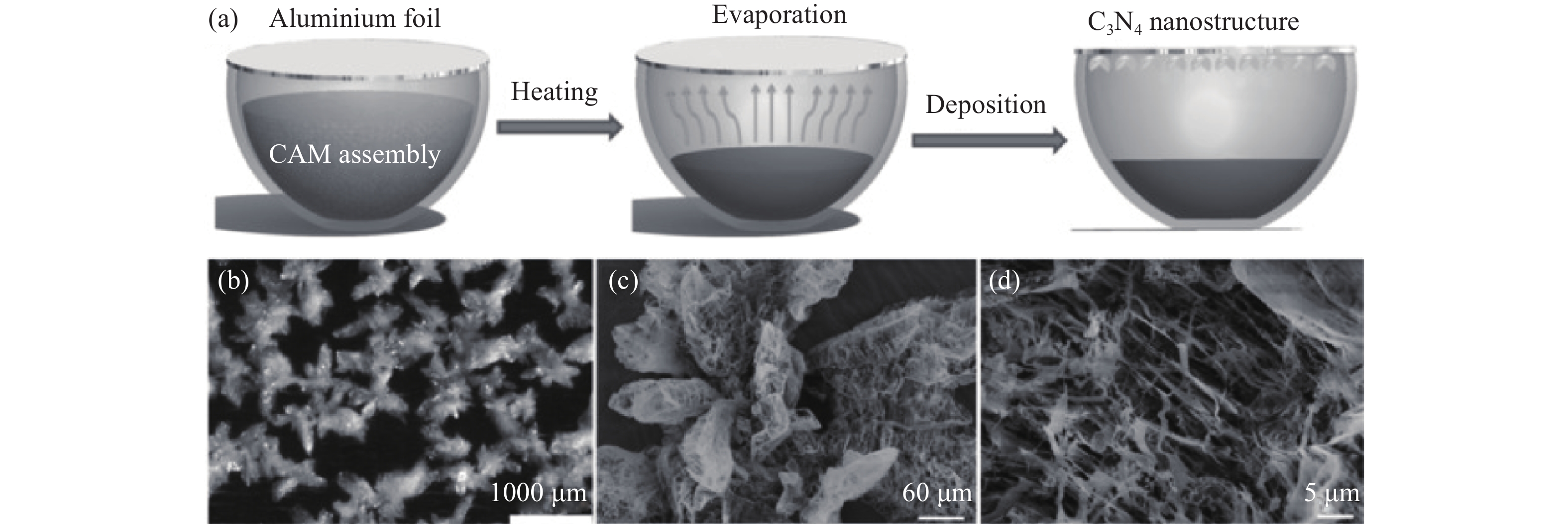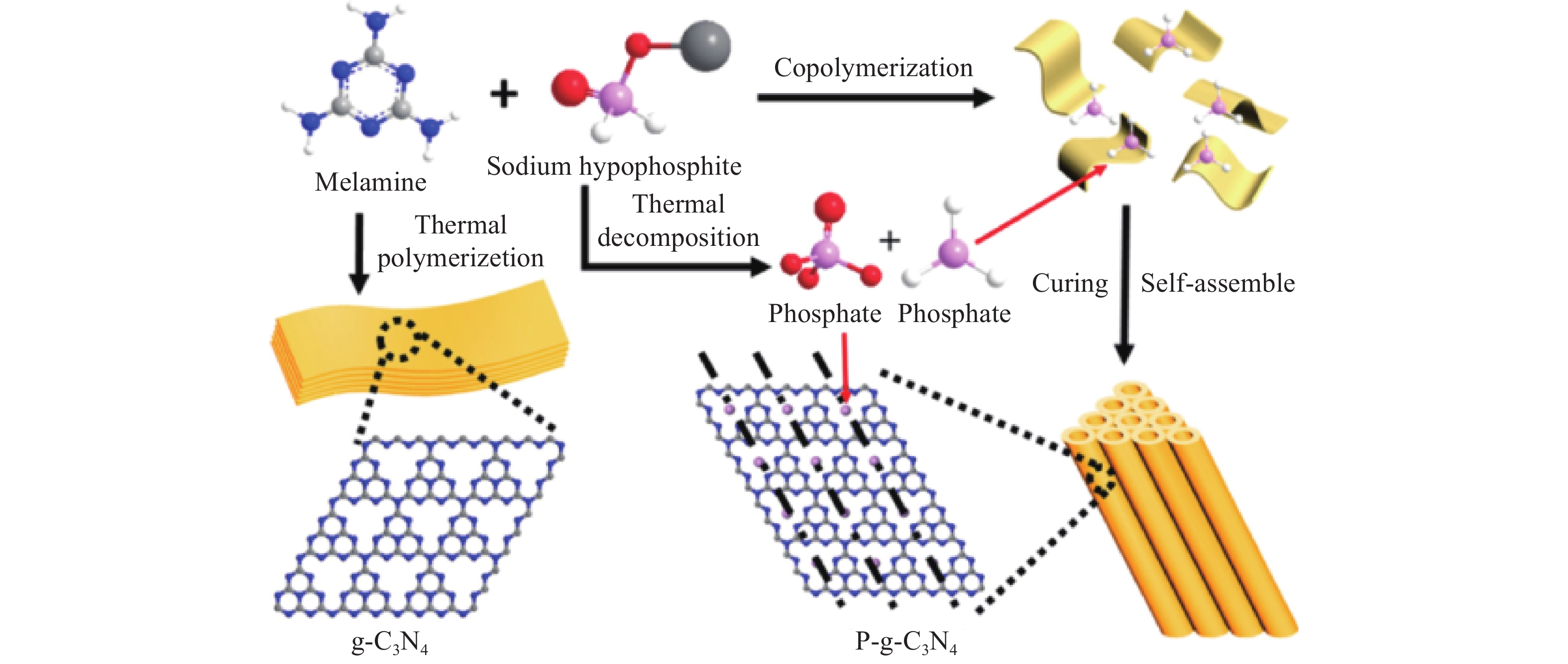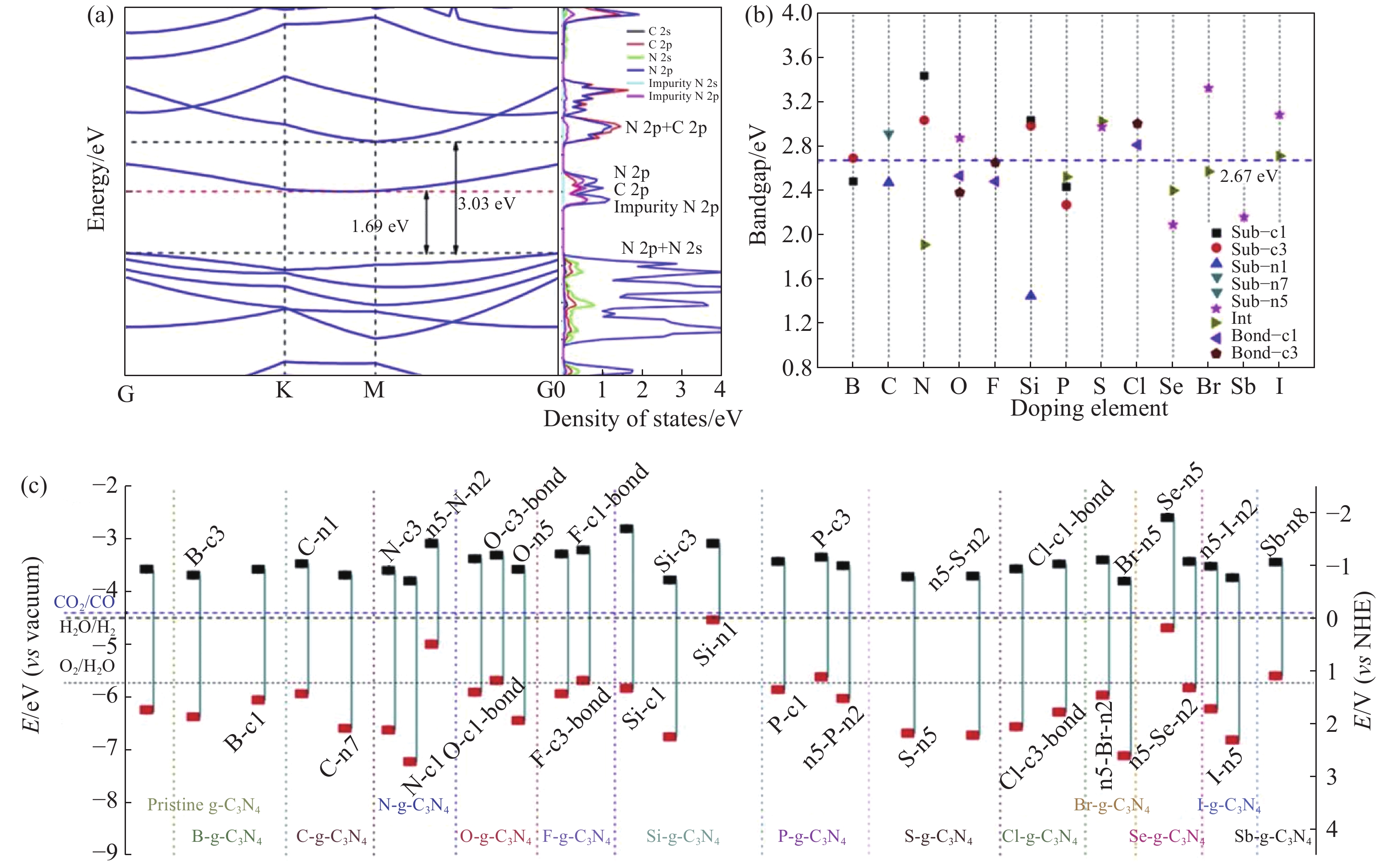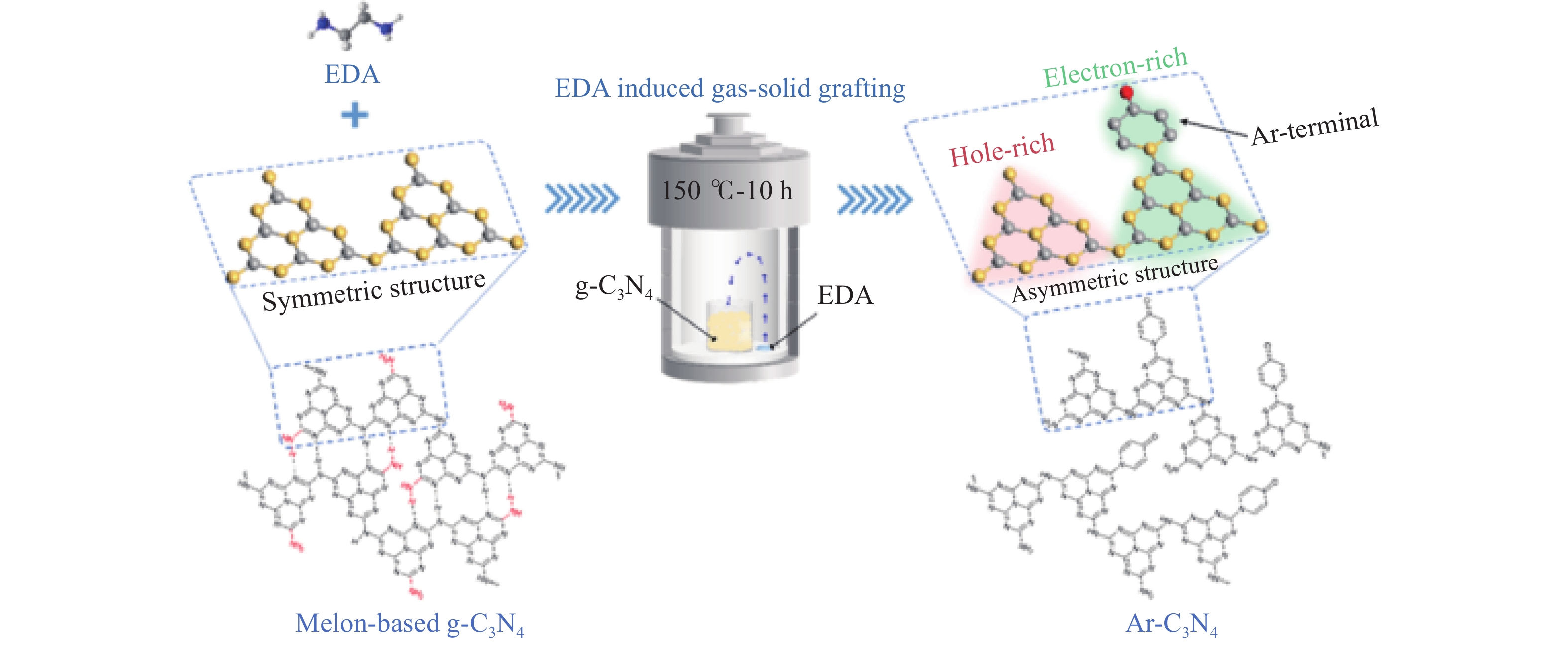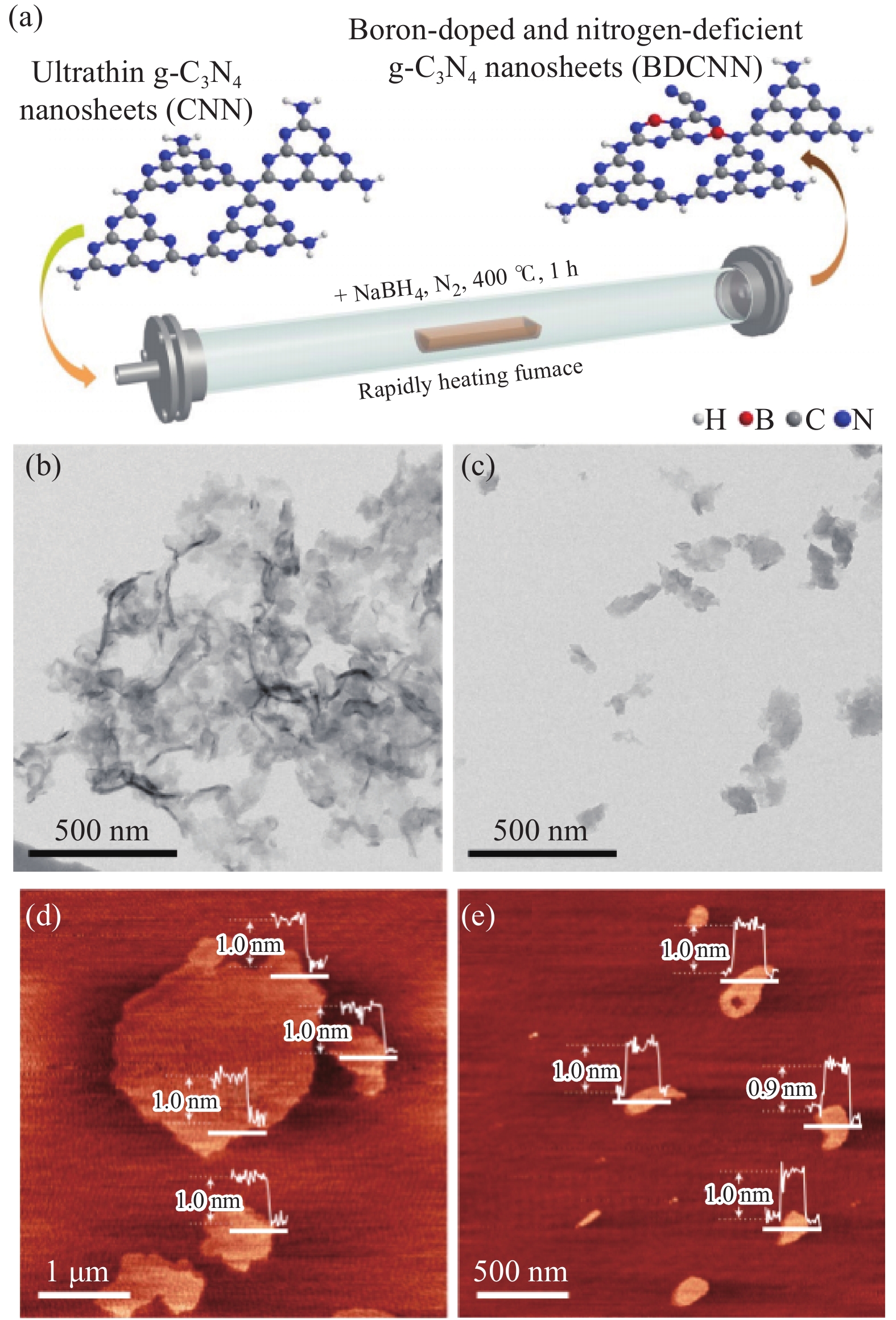Recent progress of graphitic phase carbon nitride photocatalytic materials on solar energy conversion
-
摘要: 類石墨相氮化碳(g-C3N4)作為當前光催化領域的熱點材料,盡管在可見光響應范圍和載流子的遷移/分離方面不如人意,但其不含金屬、穩定性好,結構易于調控等優點依然備受關注,尤其是近年來基于g-C3N4的形貌與電子結構調控取得了大量的突破性進展。本文系統地綜述了針對g-C3N4缺陷的不同改性和優化方法,從形貌調控、結構優化、構建異質結三方面介紹了g-C3N4光催化材料的最新研究進展,重點闡述了針對改善光催化分解水效率的各種改性優化策略。以材料的維度尺寸作為切入點介紹了不同形貌g-C3N4的制備方法,從摻雜與缺陷調控角度總結了g-C3N4結構與光生載流子分離以及催化性能的關系,并且依據不同異質結類型歸納了g-C3N4基光催化材料體系。最后,對g-C3N4基光催化材料今后的發展與面臨的挑戰進行了展望和總結。
-
關鍵詞:
- 類石墨相氮化碳(g-C3N4) /
- 形貌調控 /
- 結構優化 /
- 異質結構建 /
- 光催化析氫
Abstract: With the increasing consumption of fossil fuels, severe energy shortages and environmental issues are fast approaching. Therefore, the development of green energy resources is urgently appealed. Among them, the sunlight-driven production of hydrogen fuel with suitable photocatalysts is regarded as one of the potential strategies to meet the sustainable energy demand in the future. However, photocatalysis still faces significant uncertainties mainly because of the notorious photogenerated electron-hole (e-h) recombination and low carriers’ mobility. To achieve high photocatalytic performance, it is essential to tailor the spatial charge separation and fast charge transfer via electronic and structural manipulation of photocatalysts. As one of the hot-spot photocatalysts, graphitic phase carbon nitride (g-C3N4) has received tremendous attention in the study of solar-to-fuel (STF) conversion and carbon dioxide reduction reactions (CO2RR), owing to intrinsic merits, such as metal-free components, low-cost resources, good stability, and visible light response. Recently, considerable progress has been achieved to improve the photocatalytic STF efficiency of g-C3N4-based materials by developing strategies of structures and electric configurations engineering. In this study, different modification methods for g-C3N4 were systematically reviewed from the perspective of defects control to provide a new understanding of its structure-function relationship. Particularly, this study was composed in detail from three aspects to demonstrate the latest research progress of g-C3N4 photocatalytic materials. First, different routes toward g-C3N4 with different shapes were introduced, including 1D, 2D, and 3D. Second, doping effects and defect control on the separation and transfer of photogenerated electron-hole pairs were carefully reviewed. Finally, heterojunctions based on g-C3N4 were summarized, highlighting the Z-scheme heterojunction. In addition, some future directions and challenges for the enhancement of the photocatalytic efficiency upon g-C3N4 were pointed out according to our understanding of photocatalytic water splitting. -
圖 3 (a)二維氮化碳(550 ℃, 2 h)的掃描電鏡形貌;(b~g)在不同保溫時間下(0, 0.5, 1, 1.5, 2, 2.5 h)550 ℃熱處理制得g-C3N4的掃描電鏡形貌;(h~i)550 ℃保溫1.5 h后制得g-C3N4的掃描電鏡和透射電鏡形貌[53]
Figure 3. (a) Scanning electron microscopy (SEM) images of two-dimensional carbon nitride (550 ℃, 2 h); (b?g) SEM images of the g-C3N4 from layered organic materials in different heat preservation time at 550 ℃ with holding times of 0 h, 0.5 h, 1 h, 1.5 h, 2 h, and 2.5 h; (h–i) SEM and transmission electron microscopy images of graphitic phase carbon nitride prepared by CN at 550 ℃ for 1.5 h[53]
圖 5 (a)分層C3N4納米結構的氣固生長示意圖;(b)薄膜上C3N4納米結構的光學顯微像(OM);(c,d)薄膜上C3N4納米結構的掃描電鏡照片[60]
Figure 5. (a) Gas–solid growth diagram of layered C3N4 nanostructures; (b) optical microscope images of C3N4 nanostructures on thin films; (c and d) scanning electron microscopy images of C3N4 nanostructures on thin films[60]
圖 7 p區元素摻雜的g-C3N4電子結構.(a)摻雜能級為1.69 eV的N摻雜g-C3N4能帶結構(左)和相應的態密度(右);(b)不同摻雜劑摻雜的g-C3N4直接帶隙;(c)各種元素摻雜g-C3N4的導帶(CB,黑色)和價帶(VB,紅色)邊緣位置[72]
Figure 7. Electronic structure of the p-block element doped graphitic phase carbon nitride (g-C3N4): (a) band structure of N-doped g-C3N4 with a doping energy level of 1.69 eV (left) and the corresponding partial state density (right); (b) direct band gap of g-C3N4 doped with different dopants; (c) conduction band (black) and valence band (VB, red) edge positions of doped g-C3N4[72]
圖 11 催化劑的合成及微觀形貌。(a)由CNN衍生的BDCNN合成原理圖;(b,c)CNN和BDCNN的透射電鏡照片;(d,e)CNN和BDCNN在硅片上的原子力顯微鏡圖像及高度輪廓線[95]
Figure 11. Catalyst synthesis and microscopy: (a) schematic of the synthesis of BDCNN derived from CNN; transmission electron microscopy images of CNN (b) and BDCNN (c); AFM images of CNN (d) and BDCNN (e) on a silicon wafer with the height profile determined along the lines shown in the insets[95]
www.77susu.com<span id="fpn9h"><noframes id="fpn9h"><span id="fpn9h"></span> <span id="fpn9h"><noframes id="fpn9h"> <th id="fpn9h"></th> <strike id="fpn9h"><noframes id="fpn9h"><strike id="fpn9h"></strike> <th id="fpn9h"><noframes id="fpn9h"> <span id="fpn9h"><video id="fpn9h"></video></span> <ruby id="fpn9h"></ruby> <strike id="fpn9h"><noframes id="fpn9h"><span id="fpn9h"></span> -
參考文獻
[1] Ong W J, Tan L L, Ng Y H, et al. Graphitic carbon nitride (g-C3N4)-based photocatalysts for artificial photosynthesis and environmental remediation: Are we a step closer to achieving sustainability? Chem Rev, 2016, 116(12): 7159 [2] Kreps B H. The rising costs of fossil-fuel extraction: An energy crisis that will not go away. Am J Econ Sociol, 2020, 79(3): 695 doi: 10.1111/ajes.12336 [3] Xiao J D, Jiang H L. Metal-organic frameworks for photocatalysis and photothermal catalysis. Acc Chem Res, 2019, 52(2): 356 doi: 10.1021/acs.accounts.8b00521 [4] Kabir E, Kumar P, Kumar S, et al. Solar energy: Potential and future prospects. Renew Sustain Energy Rev, 2018, 82: 894 doi: 10.1016/j.rser.2017.09.094 [5] Jeon T H, Koo M S, Kim H, et al. Dual-functional photocatalytic and photoelectrocatalytic systems for energy- and resource-recovering water treatment. ACS Catal, 2018, 8(12): 11542 doi: 10.1021/acscatal.8b03521 [6] Peng J H, Chen X Z, Ong W J, et al. Surface and heterointerface engineering of 2D MXenes and their nanocomposites: Insights into electro- and photocatalysis. Chem, 2019, 5(1): 18 doi: 10.1016/j.chempr.2018.08.037 [7] Zhu L L, Gao M M, Peh C K N, et al. Solar-driven photothermal nanostructured materials designs and prerequisites for evaporation and catalysis applications. Mater Horiz, 2018, 5(3): 323 doi: 10.1039/C7MH01064H [8] Zhang L P, Lin C Y, Zhang D T, et al. Guiding principles for designing highly efficient metal-free carbon catalysts. Adv Mater, 2019, 31(13): 1805252 doi: 10.1002/adma.201805252 [9] Wang W, Tadé M O, Shao Z P. Nitrogen-doped simple and complex oxides for photocatalysis: A review. Prog Mater Sci, 2018, 92: 33 doi: 10.1016/j.pmatsci.2017.09.002 [10] Twilton J, Le C, Zhang P, et al. The merger of transition metal and photocatalysis. Nat Rev Chem, 2017, 1: 52 doi: 10.1038/s41570-017-0052 [11] Chen Y, Wang X C. Template-free synthesis of hollow G-C3N4 polymer with vesicle structure for enhanced photocatalytic water splitting. J Phys Chem C, 2018, 122(7): 3786 doi: 10.1021/acs.jpcc.7b12496 [12] Chen S S, Qi Y, Li C, et al. Surface strategies for particulate photocatalysts toward artificial photosynthesis. Joule, 2018, 2(11): 2260 doi: 10.1016/j.joule.2018.07.030 [13] Chen S S, Takata T, Domen K. Particulate photocatalysts for overall water splitting. Nat Rev Mater, 2017, 2: 17050 doi: 10.1038/natrevmats.2017.50 [14] Fujishima A, Honda K. Electrochemical photolysis of water at a semiconductor electrode. Nature, 1972, 238(5358): 37 doi: 10.1038/238037a0 [15] Tekin D, Kiziltas H, de Ungan H. Kinetic evaluation of ZnO/TiO2 thin film photocatalyst in photocatalytic degradation of Orange G. J Mol Liq, 2020, 306: 112905 doi: 10.1016/j.molliq.2020.112905 [16] He R, Xu D F, Cheng B, et al. Review on nanoscale Bi-based photocatalysts. Nanoscale Horizons, 2018, 3(5): 464 doi: 10.1039/C8NH00062J [17] Xu J L, Sun C F, Wang Z Y, et al. Perovskite oxide LaNiO3 nanoparticles for boosting H2 evolution over commercial CdS with visible light. Chem A Eur J, 2018, 24(69): 18512 doi: 10.1002/chem.201802920 [18] Ma S, Deng Y P, Xie J, et al. Noble-metal-free Ni3C cocatalysts decorated CdS nanosheets for high-efficiency visible-light-driven photocatalytic H2 evolution. Appl Catal B:Environ, 2018, 227: 218 doi: 10.1016/j.apcatb.2018.01.031 [19] Zhang K, Lin Y X, Muhammad Z, et al. Active {010} facet-exposed Cu2MoS4 nanotube as high-efficiency photocatalyst. Nano Res, 2017, 10(11): 3817 doi: 10.1007/s12274-017-1594-3 [20] Wu X Q, Zhao J, Wang L P, et al. Carbon dots as solid-state electron mediator for BiVO4/CDs/CdS Z-scheme photocatalyst working under visible light. Appl Catal B:Environ, 2017, 206: 501 doi: 10.1016/j.apcatb.2017.01.049 [21] Ren Y J, Zeng D Q, Ong W J. Interfacial engineering of graphitic carbon nitride (g-C3N4)-based metal sulfide heterojunction photocatalysts for energy conversion: A review. Chin J Catal, 2019, 40(3): 289 doi: 10.1016/S1872-2067(19)63293-6 [22] Wang X C, Maeda K, Thomas A, et al. A metal-free polymeric photocatalyst for hydrogen production from water under visible light. Nat Mater, 2009, 8(1): 76 doi: 10.1038/nmat2317 [23] Ren W, Cheng J J, Ou H H, et al. Optimizing the crystallization process of conjugated polymer photocatalysts to promote electron transfer and molecular oxygen activation. J Catal, 2020, 389: 636 doi: 10.1016/j.jcat.2020.07.005 [24] Gong Z Q, Yan C X, Xuan Z Y, et al. Development of template methods for the preparation of porous photocatalysts of graphite-like carbon nitride. Chin J Eng, 2021, 43(3): 345鞏正奇, 閆楚璇, 宣之易, 等. 制備類石墨相氮化碳多孔光催化劑的模板法發展. 工程科學學報, 2021, 43(3):345 [25] Zhou M, Chen Z, Yang P J, et al. Hydrogen reduction treatment of boron carbon nitrides for photocatalytic selective oxidation of alcohols. Appl Catal B:Environ, 2020, 276: 118916 doi: 10.1016/j.apcatb.2020.118916 [26] Fang Y X, Fu X Z, Wang X C. Diverse polymeric carbon nitride-based semiconductors for photocatalysis and variations. ACS Mater Lett, 2020, 2(8): 975 doi: 10.1021/acsmaterialslett.0c00215 [27] Wang X L, Yang H G. Facile fabrication of high-yield graphitic carbon nitride with a large surface area using bifunctional urea for enhanced photocatalytic performance. Appl Catal B:Environ, 2017, 205: 624 doi: 10.1016/j.apcatb.2017.01.013 [28] Gao Y, Qian K, Xu B T, et al. Designing 2D–2D g-C3N4/Ag: ZnIn2S4 nanocomposites for the high-performance conversion of sunlight energy into hydrogen fuel and the meaningful reduction of pollution. RSC Adv, 2020, 10(54): 32652 doi: 10.1039/D0RA06226J [29] Long D, Chen W L, Rao X, et al. Synergetic effect of C60/g-C3N4 nanowire composites for enhanced photocatalytic H2 evolution under visible light irradiation. ChemCatChem, 2020, 12(7): 2022 doi: 10.1002/cctc.201901958 [30] Cui Z H, Dong X A, Sun Y J, et al. Simultaneous introduction of oxygen vacancies and Bi metal onto the {001} facet of Bi3O4Cl woven nanobelts for synergistically enhanced photocatalysis. Nanoscale, 2018, 10(35): 16928 doi: 10.1039/C8NR05322G [31] Weon S, Choi E, Kim H, et al. Active {001} facet exposed TiO2 nanotubes photocatalyst filter for volatile organic compounds removal: From material development to commercial indoor air cleaner application. Environ Sci Technol, 2018, 52(16): 9330 doi: 10.1021/acs.est.8b02282 [32] Wang X, Sun G, Li N, et al. Quantum dots derived from two-dimensional materials and their applications for catalysis and energy. Chem Soc Rev, 2016, 45(8): 2239 doi: 10.1039/C5CS00811E [33] Bandyopadhyay A, Ghosh D, Kaley N M, et al. Photocatalytic activity of g-C3N4 quantum dots in visible light: Effect of physicochemical modifications. J Phys Chem C, 2017, 121(3): 1982 doi: 10.1021/acs.jpcc.6b11520 [34] Zhou L, Tian Y H, Lei J Y, et al. Self-modification of g-C3N4 with its quantum dots for enhanced photocatalytic activity. Catal Sci Technol, 2018, 8(10): 2617 doi: 10.1039/C8CY00351C [35] Zheng C, Qiu X, Han J, et al. Zero-dimensional-g-CNQD-coordinated two-dimensional porphyrin MOF hybrids for boosting photocatalytic CO2 reduction. ACS Appl Mater Interfaces, 2019, 11(45): 42243 doi: 10.1021/acsami.9b15306 [36] Zhou B X, Ding S S, Wang Y, et al. Type-II/type-II band alignment to boost spatial charge separation: A case study of g-C3N4 quantum dots/a-TiO2/r-TiO2 for highly efficient photocatalytic hydrogen and oxygen evolution. Nanoscale, 2020, 12(10): 6037 doi: 10.1039/D0NR00176G [37] Zhang L S, Ding N, Lou L C, et al. Localized surface plasmon resonance enhanced photocatalytic hydrogen evolution via Pt@Au NRs/C3N4 nanotubes under visible-light irradiation. Adv Funct Mater, 2019, 29(3): 1806774 doi: 10.1002/adfm.201806774 [38] Tian N, Xiao K, Zhang Y H, et al. Reactive sites rich porous tubular yolk-shell g-C3N4 via precursor recrystallization mediated microstructure engineering for photoreduction. Appl Catal B:Environ, 2019, 253: 196 doi: 10.1016/j.apcatb.2019.04.036 [39] Desalegn B Z, Jadhav H S, Seo J G. Highly efficient g-C3N4 nanorods with dual active sites as an electrocatalyst for the oxygen evolution reaction. Chem Cat Chem, 2019, 11(12): 2870 doi: 10.1002/cctc.201900330 [40] Zeng Y X, Liu X, Liu C B, et al. Scalable one-step production of porous oxygen-doped g-C3N4 nanorods with effective electron separation for excellent visible-light photocatalytic activity. Appl Catal B:Environ, 2018, 224: 1 doi: 10.1016/j.apcatb.2017.10.042 [41] Mo Z, Xu H, Chen Z G, et al. Self-assembled synthesis of defect-engineered graphitic carbon nitride nanotubes for efficient conversion of solar energy. Appl Catal B:Environ, 2018, 225: 154 doi: 10.1016/j.apcatb.2017.11.041 [42] Zhao X, Zhang Y, Zhao X, et al. Urea and melamine formaldehyde resin-derived tubular g-C3N4 with highly efficient photocatalytic performance. ACS Appl Mater Interfaces, 2019, 11(31): 27934 doi: 10.1021/acsami.9b08483 [43] Liu Q X, Zeng C M, Xie Z H, et al. Cobalt@nitrogen-doped bamboo-structured carbon nanotube to boost photocatalytic hydrogen evolution on carbon nitride. Appl Catal B:Environ, 2019, 254: 443 doi: 10.1016/j.apcatb.2019.04.098 [44] Ai L H, Su J F, Wang M, et al. Bamboo-structured nitrogen-doped carbon nanotube coencapsulating cobalt and molybdenum carbide nanoparticles: An efficient bifunctional electrocatalyst for overall water splitting. ACS Sustain Chem Eng, 2018, 6(8): 9912 doi: 10.1021/acssuschemeng.8b01120 [45] Zhao S, Fang J S, Wang Y Y, et al. Poly(ionic liquid)-assisted synthesis of open-ended carbon nitride tube for efficient photocatalytic hydrogen evolution under visible-light irradiation. ACS Sustainable Chem Eng, 2019, 7(11): 10095 doi: 10.1021/acssuschemeng.9b01544 [46] Yang L Q, Huang J F, Shi L, et al. A surface modification resultant thermally oxidized porous g-C3N4 with enhanced photocatalytic hydrogen production. Appl Catal B:Environ, 2017, 204: 335 doi: 10.1016/j.apcatb.2016.11.047 [47] Fu J W, Xu Q L, Low J, et al. Ultrathin 2D/2D WO3/g-C3N4 step-scheme H2-production photocatalyst. Appl Catal B:Environ, 2019, 243: 556 doi: 10.1016/j.apcatb.2018.11.011 [48] Sun S, Liang S. Recent advances in functional mesoporous graphitic carbon nitride (mpg-C3N4) polymers. Nanoscale, 2017, 9(30): 10544 doi: 10.1039/C7NR03656F [49] Yang P J, Ou H H, Fang Y X, et al. A facile steam reforming strategy to delaminate layered carbon nitride semiconductors for photoredox catalysis. Angewandte Chemie Int Ed, 2017, 56(14): 3992 doi: 10.1002/anie.201700286 [50] Wang W, Fang J J, Chen H, et al. Rice-husk-derived mesoporous 0D/2D C3N4 isotype heterojunction with improved quantum effect for photodegradation of tetracycline antibiotics. Ceram Int, 2019, 45(2): 2234 doi: 10.1016/j.ceramint.2018.10.136 [51] Lin B, An H, Yan X Q, et al. Fish-scale structured g-C3N4 nanosheet with unusual spatial electron transfer property for high-efficiency photocatalytic hydrogen evolution. Appl Catal B:Environ, 2017, 210: 173 doi: 10.1016/j.apcatb.2017.03.066 [52] Yuan Y J, Shen Z K, Wu S T, et al. Liquid exfoliation of g-C3N4 nanosheets to construct 2D-2D MoS2/g-C3N4 photocatalyst for enhanced photocatalytic H2 production activity. Appl Catal B:Environ, 2019, 246: 120 doi: 10.1016/j.apcatb.2019.01.043 [53] Zhao G, Cheng Y L, Wu Y Z, et al. New 2D carbon nitride organic materials synthesis with huge-application prospects in CN photocatalyst. Small, 2018, 14(15): 1704138 doi: 10.1002/smll.201704138 [54] Shu Z, Wang Y, Wang W, et al. A green one-pot approach for mesoporous g-C3N4 nanosheets with in situ sodium doping for enhanced photocatalytic hydrogen evolution. Int J Hydrogen Energy, 2019, 44(2): 748 doi: 10.1016/j.ijhydene.2018.11.025 [55] Li X B, Xiong J, Gao X M, et al. Recent advances in 3D g-C3N4 composite photocatalysts for photocatalytic water splitting, degradation of pollutants and CO2 reduction. J Alloys Compd, 2019, 802: 196 doi: 10.1016/j.jallcom.2019.06.185 [56] Liu M, Wageh S, Al-Ghamdi A A, et al. Quenching induced hierarchical 3D porous g-C3N4 with enhanced photocatalytic CO2 reduction activity. Chem Commun (Camb) , 2019, 55(93): 14023 doi: 10.1039/C9CC07647F [57] Cao Y Z, Gao Q, Li Q, et al. Synthesis of 3D porous MoS2/g-C3N4 heterojunction as a high efficiency photocatalyst for boosting H2 evolution activity. RSC Adv, 2017, 7(65): 40727 doi: 10.1039/C7RA06774G [58] Fang Z Y, Hong Y Z, Li D, et al. One-step nickel foam assisted synthesis of holey G-carbon nitride nanosheets for efficient visible-light photocatalytic H2 evolution. ACS Appl Mater Interfaces, 2018, 10(24): 20521 doi: 10.1021/acsami.8b04783 [59] Yu W W, Zhang T, Zhao Z K. Garland-like intercalated carbon nitride prepared by an oxalic acid-mediated assembly strategy for highly-efficient visible-light-driven photoredox catalysis. Appl Catal B:Environ, 2020, 278: 119342 doi: 10.1016/j.apcatb.2020.119342 [60] Xu J S, Wang H, Zhang C, et al. From millimeter to subnanometer: Vapor-solid deposition of carbon nitride hierarchical nanostructures directed by supramolecular assembly. Angewandte Chemie, 2017, 129(29): 8546 doi: 10.1002/ange.201611946 [61] Tong Z W, Yang D, Zhao X Y, et al. Bio-inspired synthesis of three-dimensional porous g-C3N4@carbon microflowers with enhanced oxygen evolution reactivity. Chem Eng J, 2018, 337: 312 doi: 10.1016/j.cej.2017.12.064 [62] Ba G M, Liang Z W, Li H P, et al. Synthesis of hierarchically mesoporous polymeric carbon nitride with mesoporous melamine as a precursor for enhanced photocatalytic performance. Chem Eng J, 2020, 380: 122535 doi: 10.1016/j.cej.2019.122535 [63] Zheng Y, Lin L H, Wang B, et al. Graphitic carbon nitride polymers toward sustainable photoredox catalysis. Angewandte Chemie Int Ed, 2015, 54(44): 12868 doi: 10.1002/anie.201501788 [64] Yuan J L, Yi X Y, Tang Y H, et al. Efficient photocatalytic hydrogen evolution and CO2 reduction: enhanced light absorption, charge separation, and hydrophilicity by tailoring terminal and linker units in g-C3N4. ACS Appl Mater Interfaces, 2020, 12: 19607 doi: 10.1021/acsami.0c04028 [65] Wang K, Fu J L, Zheng Y. Insights into photocatalytic CO2 reduction on C3N4: Strategy of simultaneous B, K co-doping and enhancement by N vacancies. Appl Catal B:Environ, 2019, 254: 270 doi: 10.1016/j.apcatb.2019.05.002 [66] Yang C, Zhang S S, Huang Y, et al. Sharply increasing the visible photoreactivity of g-C3N4 by breaking the intralayered hydrogen bonds. Appl Surf Sci, 2020, 505: 144654 doi: 10.1016/j.apsusc.2019.144654 [67] Liu B, Ye L, Wang R, et al. Phosphorus-doped graphitic carbon nitride nanotubes with amino-rich surface for efficient CO2 capture, enhanced photocatalytic activity, and product selectivity. ACS Appl Mater Interfaces, 2018, 10(4): 4001 doi: 10.1021/acsami.7b17503 [68] Yan Q, Huang G F, Li D F, et al. Facile synthesis and superior photocatalytic and electrocatalytic performances of porous B-doped g-C3N4 nanosheets. J Mater Sci Technol, 2018, 34(12): 2515 doi: 10.1016/j.jmst.2017.06.018 [69] Sun S D, Li J, Cui J, et al. Simultaneously engineering K-doping and exfoliation into graphitic carbon nitride (g-C3N4) for enhanced photocatalytic hydrogen production. Int J Hydrog Energy, 2019, 44(2): 778 doi: 10.1016/j.ijhydene.2018.11.019 [70] Wang C, Fan H Q, Ren X H, et al. Hydrothermally induced oxygen doping of graphitic carbon nitride with a highly ordered architecture and enhanced photocatalytic activity. ChemSusChem, 2018, 11(4): 700 doi: 10.1002/cssc.201702278 [71] Iqbal W, Yang B, Zhao X, et al. Facile one-pot synthesis of mesoporous g-C3N4 nanosheets with simultaneous iodine doping and N-vacancies for efficient visible-light-driven H2 evolution performance. Catal Sci Technol, 2020, 10(2): 549 doi: 10.1039/C9CY02111F [72] Zhu Y H, Gong L L, Zhang D T, et al. Catalytic origin and universal descriptors of heteroatom-doped photocatalysts for solar fuel production. Nano Energy, 2019, 63: 103819 doi: 10.1016/j.nanoen.2019.06.015 [73] Li Y L, Xu X F, Wang J S, et al. Post-redox engineering electron configurations of atomic thick C3N4 nanosheets for enhanced photocatalytic hydrogen evolution. Appl Catal B:Environ, 2020, 270: 118855 doi: 10.1016/j.apcatb.2020.118855 [74] Luo W, Li Y L, Wang J S, et al. Asymmetric structure engineering of polymeric carbon nitride for visible-light-driven reduction reactions. Nano Energy, 2021, 87: 106168 doi: 10.1016/j.nanoen.2021.106168 [75] Wang L Y, Wang K H, He T T, et al. Graphitic carbon nitride-based photocatalytic materials: Preparation strategy and application. ACS Sustain Chem Eng, 2020, 8(43): 16048 doi: 10.1021/acssuschemeng.0c05246 [76] Li X H, Zhang J, Zhou F, et al. Preparation of N-vacancy-doped g-C3N4 with outstanding photocatalytic H2O2 production ability by dielectric barrier discharge plasma treatment. Chin J Catal, 2018, 39(6): 1090 doi: 10.1016/S1872-2067(18)63046-3 [77] Tu W G, Xu Y, Wang J J, et al. Investigating the role of tunable nitrogen vacancies in graphitic carbon nitride nanosheets for efficient visible-light-driven H2 evolution and CO2 reduction. ACS Sustain Chem Eng, 2017, 5(8): 7260 doi: 10.1021/acssuschemeng.7b01477 [78] Liang Q H, Li Z, Huang Z H, et al. Holey graphitic carbon nitride nanosheets with carbon vacancies for highly improved photocatalytic hydrogen production. Adv Funct Mater, 2015, 25(44): 6885 doi: 10.1002/adfm.201503221 [79] Li Y F, Yang M, Xing Y, et al. Preparation of carbon-rich g-C3N4 nanosheets with enhanced visible light utilization for efficient photocatalytic hydrogen production. Small, 2017, 13(33): 1701552 doi: 10.1002/smll.201701552 [80] Bai T Y, Shi X F, Liu M, et al. g-C3N4/ZnCdS heterojunction for efficient visible light-driven photocatalytic hydrogen production. RSC Adv, 2021, 11: 38120 doi: 10.1039/D1RA05894K [81] Rhimi B, Wang C Y, Bahnemann D W. Latest progress in g-C3N4 based heterojunctions for hydrogen production via photocatalytic water splitting: A mini review. J Phys Energy, 2020, 2(4): 042003 doi: 10.1088/2515-7655/abb782 [82] Huang D L, Yan X L, Yan M, et al. Graphitic carbon nitride-based heterojunction photoactive nanocomposites: Applications and mechanism insight. ACS Appl Mater Interfaces, 2018, 10(25): 21035 doi: 10.1021/acsami.8b03620 [83] Fu J W, Yu J G, Jiang C J, et al. G-C3N4-based heterostructured photocatalysts. Adv Energy Mater, 2018, 8(3): 1701503 doi: 10.1002/aenm.201701503 [84] Kong Z Z, Chen X Z, Ong W J, et al. Atomic-level insight into the mechanism of 0D/2D black phosphorus quantum dot/graphitic carbon nitride (BPQD/GCN) metal-free heterojunction for photocatalysis. Appl Surf Sci, 2019, 463: 1148 doi: 10.1016/j.apsusc.2018.09.026 [85] Ong W J, Putri L K, Tan Y C, et al. Unravelling charge carrier dynamics in protonated g-C3N4 interfaced with carbon nanodots as co-catalysts toward enhanced photocatalytic CO2 reduction: A combined experimental and first-principles DFT study. Nano Res, 2017, 10(5): 1673 doi: 10.1007/s12274-016-1391-4 [86] Shen L Y, Xing Z P, Zou J L, et al. Black TiO2 nanobelts/g-C3N4 nanosheets laminated heterojunctions with efficient visible-light-driven photocatalytic performance. Sci Rep, 2017, 7: 41978 doi: 10.1038/srep41978 [87] Yang L Q, Huang J F, Shi L, et al. Sb doped SnO2-decorated porous g-C3N4 nanosheet heterostructures with enhanced photocatalytic activities under visible light irradiation. Appl Catal B:Environ, 2018, 221: 670 doi: 10.1016/j.apcatb.2017.09.041 [88] Afroz K, Moniruddin M, Bakranov N, et al. A heterojunction strategy to improve the visible light sensitive water splitting performance of photocatalytic materials. J Mater Chem A, 2018, 6(44): 21696 doi: 10.1039/C8TA04165B [89] Kumar A, Raizada P, Singh P, et al. Perspective and status of polymeric graphitic carbon nitride based Z-scheme photocatalytic systems for sustainable photocatalytic water purification. Chem Eng J, 2020, 391: 123496 doi: 10.1016/j.cej.2019.123496 [90] Jiang D L, Ma W X, Xiao P, et al. Enhanced photocatalytic activity of graphitic carbon nitride/carbon nanotube/Bi2WO6 ternary Z-scheme heterojunction with carbon nanotube as efficient electron mediator. J Colloid Interface Sci, 2018, 512: 693 doi: 10.1016/j.jcis.2017.10.074 [91] Wu M Q, Ding T, Wang Y T, et al. Rational construction of plasmon Au assisted ferroelectric-BaTiO3/Au/g-C3N4 Z-scheme system for efficient photocatalysis. Catal Today, 2020, 355: 311 doi: 10.1016/j.cattod.2019.04.061 [92] Jo W K, Selvam N C S. Z-scheme CdS/g-C3N4 composites with RGO as an electron mediator for efficient photocatalytic H2 production and pollutant degradation. Chem Eng J, 2017, 317: 913 doi: 10.1016/j.cej.2017.02.129 [93] Bafaqeer A, Tahir M, Ali Khan A, et al. Indirect Z-scheme assembly of 2D ZnV2O6/RGO/g-C3N4 nanosheets with RGO/pCN as solid-state electron mediators toward visible-light-enhanced CO2 reduction. Ind Eng Chem Res, 2019, 58(20): 8612 doi: 10.1021/acs.iecr.8b06053 [94] Yang Y, Wu J J, Xiao T T, et al. Urchin-like hierarchical CoZnAl-LDH/RGO/g-C3N4 hybrid as a Z-scheme photocatalyst for efficient and selective CO2 reduction. Appl Catal B:Environ, 2019, 255: 117771 doi: 10.1016/j.apcatb.2019.117771 [95] Zhao D M, Wang Y Q, Dong C L, et al. Boron-doped nitrogen-deficient carbon nitride-based Z-scheme heterostructures for photocatalytic overall water splitting. Nat Energy, 2021, 6(4): 388 doi: 10.1038/s41560-021-00795-9 [96] Shen R C, He K L, Zhang A P, et al. In-situ construction of metallic Ni3C@Ni core-shell cocatalysts over g-C3N4 nanosheets for shell-thickness-dependent photocatalytic H2 production. Appl Catal B:Environ, 2021, 291: 120104 doi: 10.1016/j.apcatb.2021.120104 [97] Ren D D, Zhang W N, Ding Y N, et al. In situ fabrication of robust cocatalyst-free CdS/g-C3N4 2D-2D step-scheme heterojunctions for highly active H2 evolution. Sol RRL, 2020, 4(8): 1900423 doi: 10.1002/solr.201900423 [98] Liu D N, Chen D Y, Li N J, et al. ZIF-67-derived 3D hollow mesoporous crystalline Co3O4 wrapped by 2D g-C3N4 nanosheets for photocatalytic removal of nitric oxide. Small, 2019, 15(31): 1902291 doi: 10.1002/smll.201902291 -




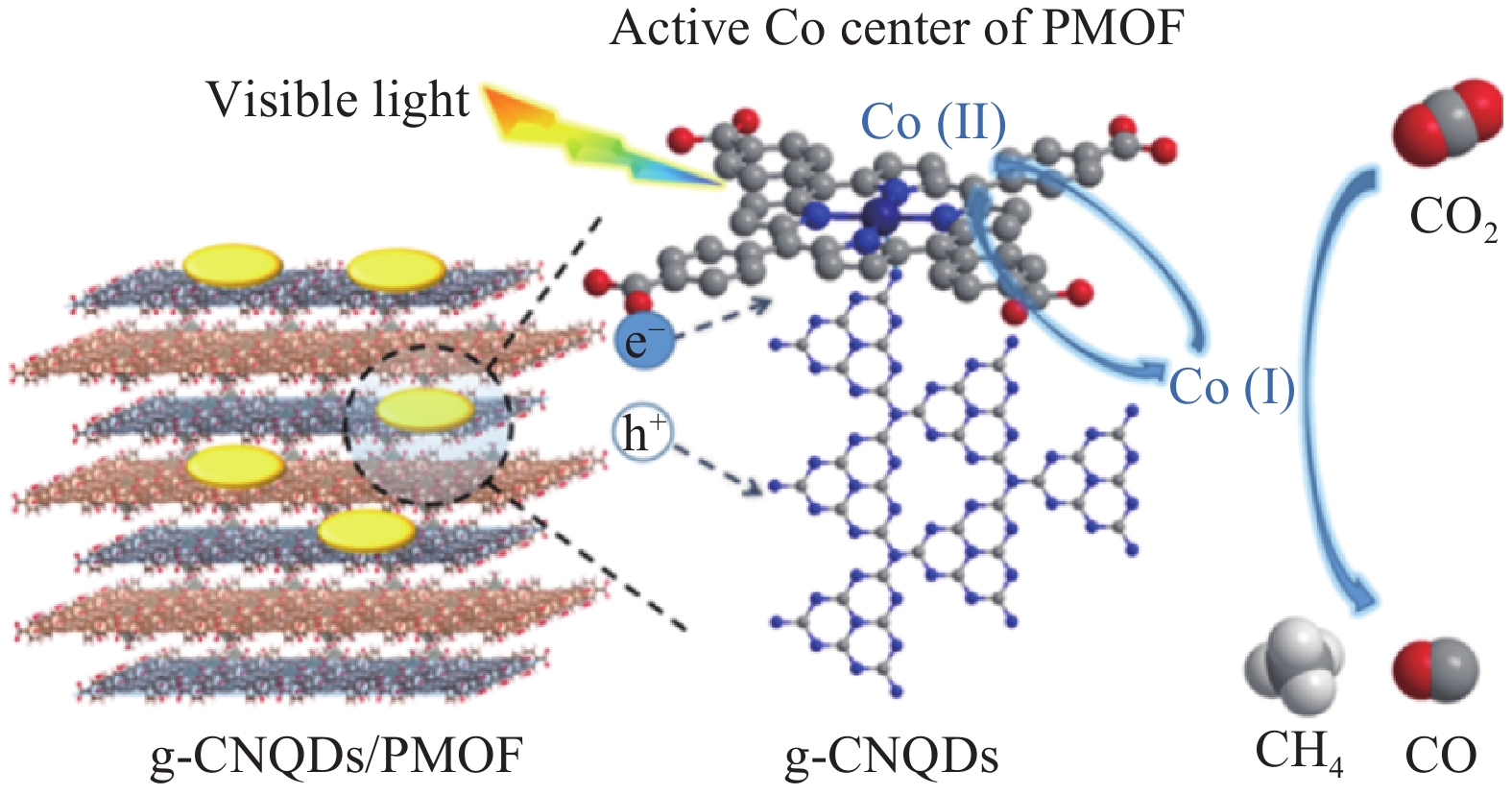
 下載:
下載:

